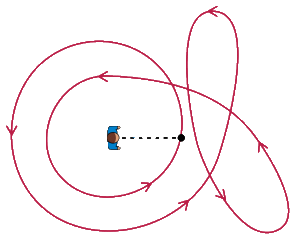turning number
Jump to navigation
Jump to search
English[edit]
Noun[edit]

turning number (plural turning numbers)
- (geometry, topology, mathematical analysis) A version of winding number in which the number of rotations is counted with respect to the tangent of the curve rather than a fixed point.
- 1989, Wayne Sewell, Weaving a Program: Literate Programming in WEB, page 516:
- This program illustrates the Whitney-Graustein theorem, that two closed curves (immersions of the circle) in the plane can be deformed into one another without letting go of the immersion property if and only if their turning numbers are the same.
- 1998, Karsten Groβe-Brauckmann, Robert B. Kusner, John M. Sullivan, “Constant Mean Curvature Surfaces with Cylindrical Ends”, in Hans-Christian Hege, Konrad Polthier, editors, Mathematical Visualization: Algorithms, Applications and Numerics, Springer, page 114:
- Moreover, l gives the turning number of the k-gon one sees in the horizontal symmetry plane when the axes of the ends are deleted. […] Moreover, every even k ≥ 30 except for 32, 36, 40, 44, 48 52 an 56 gives an example, while for every even k > 102 there is more than one example since different turning numbers are possible.
- 2002, Journal of Physics: Mathematical and general, page 6187,
- For any oriented curve of class ( is the arclength parametrization) lying in an oriented Euclidean plane E, the turning number may be defined as
- where is the signed curvature of β.
- For any oriented curve of class ( is the arclength parametrization) lying in an oriented Euclidean plane E, the turning number may be defined as
Usage notes[edit]
- In the animation, the smaller loop that does not go around the origin is also counted.
Further reading[edit]
 Immersion (mathematics) on Wikipedia.Wikipedia
Immersion (mathematics) on Wikipedia.Wikipedia  Total curvature on Wikipedia.Wikipedia
Total curvature on Wikipedia.Wikipedia
![{\displaystyle \beta (\tau ),\tau \in I,I=\left[0,\Lambda \right]}](https://wikimedia.org/api/rest_v1/media/math/render/svg/86c2e1f00cbedcba98390570c07b0e4327d81521)




